 |
 |
 |
| |
Estimated Glomerular Filtration Rates (eGFR) through 144 Weeks on Therapy in HIV-infected Subjects Receiving Atazanavir/ Ritonavir and Abacavir/Lamivudine or Simplified to Unboosted Atazanavir/Abacavir/Lamivudine
|
| |
| |
Reported by Jules Levin
14th International Workshop on Co-morbidities and Adverse Events in HIV; July 19-21, 2012; Washington, DC
B Young1, KE Squires2, K Tashima3, K Henry4, S Schneider5, A LaMarca6, HH Zhao7, LL Ross7, and MS Shaefer8 for the ARIES study team
1Rocky Mountain CARES, Denver, CO, USA; International Association of Physicians in AIDS Care, Washington DC, USA; 2Jefferson Medical College of Thomas Jefferson University, Philadelphia, PA, USA; 3Miriam Hospital Brown Univ., Providence, RI, USA; 4Hennipen County Medical Center, Minneapolis MN, USA; 5Living Hope Clinic Foundation, Long Beach CA, USA; 6Therafirst Medical Center, Ft. Lauderdale, FL, USA; 7GlaxoSmithKline, Research Triangle Park, NC, USA; 8ViiV Healthcare, Research Triangle Park, NC, USA.
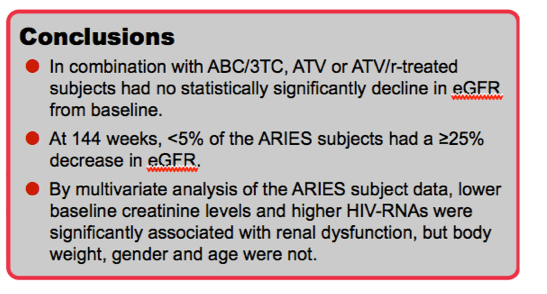
Introduction
Previous studies have suggested an increased risk of significant eGFR decline in subjects receiving boosted protease inhibitors, including atazanavir/ritonavir (ATV/r)-containing regimens.
Renal function was evaluated for extension phase subjects in the open-label , multicenter, randomized study ARIES. In ARIES, similar efficacy and tolerability were observed for ATV compared to ATV/r-treated HIV-1-infected subjects, each given in combination with abacavir/lamivudine (ABC/3TC) after initial suppression with ABC/3TC + ATV/r. 1.2
Methods
Eligible HLA B*701 negative ART-naïve subjects enrolled into ARIES received ABC/3TC + ATV/r followed by randomization (1:1) at week 36 to maintain or discontinue RTV to 84 weeks; subjects enrolled in the study at week 84 could provide consent and participate in the optional extension phase on their randomized therapy for an additional 60 weeks for a total of 144 weeks of treatment.1.2
Randomization criteria were as follows: confirmed RNA <50 c/mL prior to Week 36; RNA <50 c/mL immediately preceding Week 36, and no protocol defined virologic failure (CVF). Subjects were not required to withdraw or become ineligible to participate in the extension phase if their viral load at Week 36 or 84 were >50copies/mL. Post randomization, withdrawal was only required if HIV-RNA was >400c/ml on two consecutive visits (CVF) and the confirmatory viral load was >200copies/mL.
The eGFR change from baseline and the incidence of renal dysfunction, defined as a ≥25% decline from baseline using the Modifications of Diet in Renal Disease (MDRD) formula, were determined for each group.3
The effect of atazanavir on renal dysfunction was assessed by multivariate Cox hazards model.
Changes in eGFR over 144 weeks were evaluated using repeated mixed effects models.
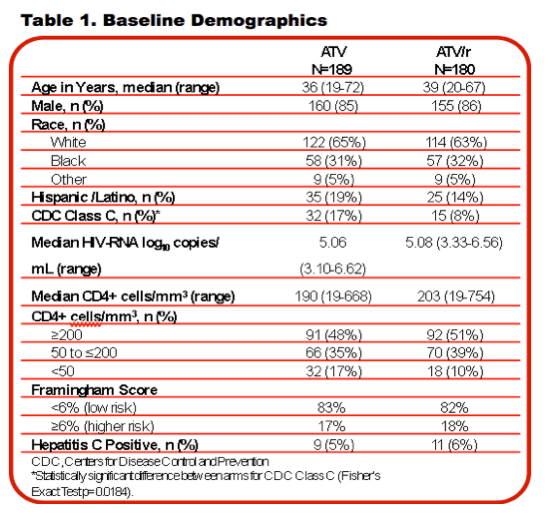
RESULTS
189/369 and 180/369 subjects were randomized to the ATV-simplification and ATV/r-continuation groups. Baseline Demographic presented in Table 1.
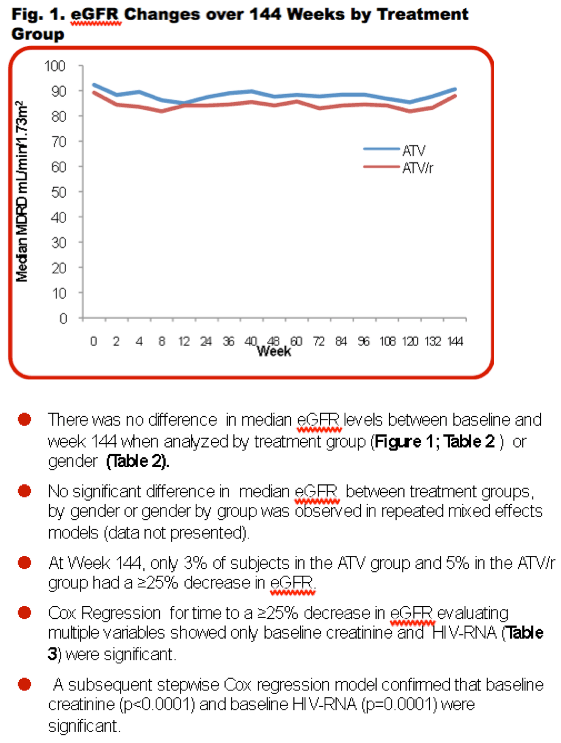
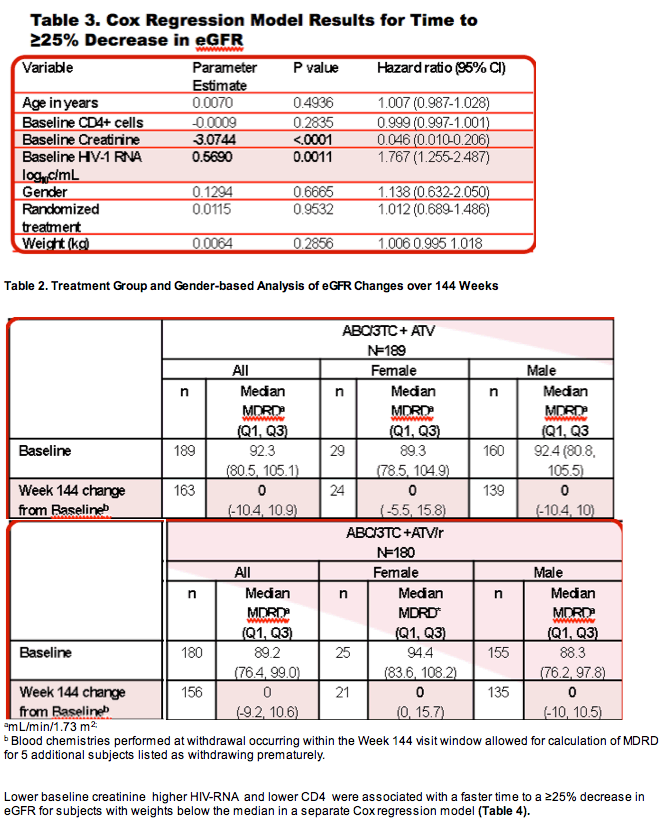
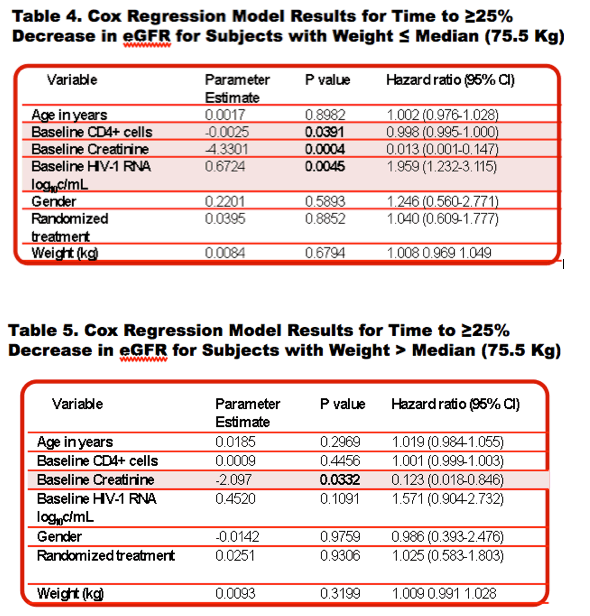
Chronic kidney disease (CKD) stage was estimated using Renal Association parameters4 and compared from baseline to week 144 for all subjects.
- In the ATV group, 155 subjects with stage 1/2 at baseline has no change at Week 144; 2 subjects went from stage 1 /2 to stage 3, 3 subjects went down from stage 3 to stage 1 /2, and 3 subjects with baseline stage 3 remained at stage 3 at Week 144.
- In the ATV/r group, 148 subjects with stage 1/2 at baseline has no change at Week 144; 2 subjects went from stage 1 /2 to stage 3, 3 subjects went down from stage 3 to stage 1 /2, and 3 subjects at stage 3 remained at stage 3 at Week 144.
Overall, two subjects on each arm had an estimated increase in CKD from stage 1 or 2 to stage 3 over 144 weeks, while 3 subjects on each arm experienced a decrease in estimated CKD from stage 3 to stage 1 or 2.
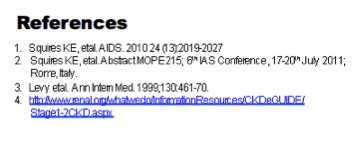
|
| |
|
 |
 |
|
|